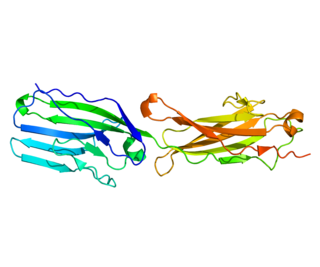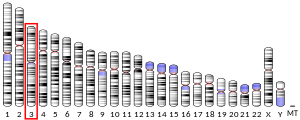The L1 family is a family of cell adhesion molecules that includes four different L1-like proteins. They are members of the immunoglobulin superfamily. The members of the L1-family in humans are called L1 or L1cam, CHL1, Neurofascin and NRCAM. L1 family members are found on neurons, especially on their axons. Sometimes they are found on glia, such as Schwann cells, radial glia and Bergmann glia cells and, as such, are important for neural cell migration during development. L1 family members are expressed throughout the vertebrate and invertebrate kingdoms.

L1, also known as L1CAM, is a transmembrane protein member of the L1 protein family, encoded by the L1CAM gene. This protein, of 200 to 220 kDa, is a neuronal cell adhesion molecule with a strong implication in cell migration, adhesion, neurite outgrowth, myelination and neuronal differentiation. It also plays a key role in treatment-resistant cancers due to its function. It was first identified in 1984 by M. Schachner who found the protein in post-mitotic mice neurons.

Lysophosphatidic acid receptor 2 also known as LPA2 is a protein that in humans is encoded by the LPAR2 gene. LPA2 is a G protein-coupled receptor that binds the lipid signaling molecule lysophosphatidic acid (LPA).

Cadherin EGF LAG seven-pass G-type receptor 1 also known as flamingo homolog 2 or cadherin family member 9 is a protein that in humans is encoded by the CELSR1 gene.

Contactin 1 (CNTN1) is a protein which in humans is encoded by the CNTN1 gene.

CD166 antigen is a 100-105 kD typeI transmembrane glycoprotein that is a member of the immunoglobulin superfamily of proteins. In humans it is encoded by the ALCAM gene. It is also called CD166, MEMD, SC-1/DM-GRASP/BEN in the chicken, and KG-CAM in the rat.

Contactin-2 is a protein that in humans is encoded by the CNTN2 gene.

Neurofascin is a protein that in humans is encoded by the NFASC gene.

Basal cell adhesion molecule, also known as Lutheran antigen, is a plasma membrane glycoprotein that in humans is encoded by the BCAM gene. BCAM has also recently been designated CD239.

Neuronal cell adhesion molecule is a protein that in humans is encoded by the NRCAM gene.

Protein melan-A also known as melanoma antigen recognized by T cells 1 or MART-1 is a protein that in humans is encoded by the MLANA or "MALENA" gene. A fragment of the protein, usually consisting of the nine amino acids 27 to 35, is bound by MHC class I complexes which present it to T cells of the immune system. These complexes can be found on the surface of melanoma cells. Decameric peptides (26-35) are being investigated as cancer vaccines.

Alpha-N-acetylneuraminide alpha-2,8-sialyltransferase is an enzyme that in humans is encoded by the ST8SIA1 gene.

Opioid-binding protein/cell adhesion molecule is a protein that in humans is encoded by the OPCML gene.

Contactin-4 is a protein that in humans is encoded by the CNTN4 gene.

Cell adhesion molecule 3 is a protein that in humans is encoded by the CADM3 gene.

Neurotrimin is a protein that in humans is encoded by the NTM gene.

Semaphorin-6A is a protein that in humans is encoded by the SEMA6A gene.

Contactin-associated protein-like 4 is a protein that in humans is encoded by the CNTNAP4 gene.

Contactin 6 is a protein in humans that is encoded by the CNTN6 gene.

Nectin-3, also known as nectin cell adhesion molecule 3, is a protein that in humans is encoded by the NECTIN3 gene.

















